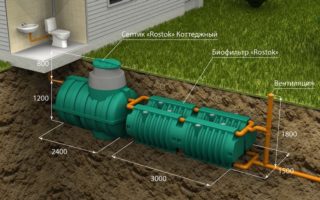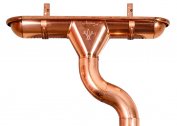Many people associate local sewage in a private house with a concrete well that exudes unpleasant odors and requires periodic pumping. However, sewage can be absolutely safe, convenient and inconspicuous. You will still have to look after her, but you will need to do this less frequently, which will significantly reduce the cost and time for maintenance.
The principle of operation of autonomous sewage
 Not all new villages or summer cottages are equipped with a central sewage system, and drains from the toilet, bathroom and kitchen need to be put somewhere. Depending on how much time it is planned to spend in the house or in the country, you can install an autonomous sewer.
Not all new villages or summer cottages are equipped with a central sewage system, and drains from the toilet, bathroom and kitchen need to be put somewhere. Depending on how much time it is planned to spend in the house or in the country, you can install an autonomous sewer.
The principle of its work is as follows:
- From every household appliance that uses water — a washing machine or a dishwasher — drains flow through the pipes to the central riser. The same goes for the toilet, bath, sinks.
- On the central riser, dirty water descends into an outer pipe located on a slope. Then it flows into the sump, a two-chamber septic tank, a cesspool.
- Biodegradation of liquids may take place in the cesspool or it may simply be removed by a sewer machine.
The methods for cleaning a cesspool or septic tank are different. It depends on what scheme the sewage system is equipped with. There are methods:
- Chemical. With the help of reagents, solids precipitate, the fluid is pumped out and disposed of. The method is rarely used, because the drugs are expensive and mostly poisonous. After them, you can not use more environmentally friendly methods, since a harmful environment will destroy bacteria.
- Biological. Based on the work of anaerobic and aerobic microorganisms. There is a technology for producing gas and organic fertilizer from the fecal masses of farm animals. It is used mainly on large farms and completely utilizes waste. The house and outbuildings are heated by methane produced.
- Mechanical. This is the easiest way, based on regular pumping of wastewater and its removal outside the site. Not the most environmentally friendly and profitable, but simple and cheap. You can do it yourself without any help.
Which sewerage to choose for a private house or cottage, depends on the budget and technical capabilities.
Advantages and disadvantages of autonomous sewage
 Even the latest technology has its drawbacks. Firstly, they are expensive and require preliminary calculations by specialists. Expensive designs are the consumption of materials and the remuneration of workers. But if you live in a private house all the time, then there is no other way out - you need to make two or three-chamber wells and filtration fields in order to order a car less often and take out waste. It is better when the drains from the toilet fall into a separate septic tank and are processed by bacteria in it, and the water with chemicals will be in another sump.
Even the latest technology has its drawbacks. Firstly, they are expensive and require preliminary calculations by specialists. Expensive designs are the consumption of materials and the remuneration of workers. But if you live in a private house all the time, then there is no other way out - you need to make two or three-chamber wells and filtration fields in order to order a car less often and take out waste. It is better when the drains from the toilet fall into a separate septic tank and are processed by bacteria in it, and the water with chemicals will be in another sump.
If possible, you need to get some benefit from the processed liquid. If the budget allows, it is recommended to buy equipment for the production of methane or to make fertilizers for the garden using biotechnologies.
Storm sewage should not be mixed with feces. A large amount of precipitation can lead to overflow of the septic tank and their spill over the site. In addition, rainwater can be collected and used in hot weather to water garden plants.
The advantage of installing an autonomous system is the ecological cleanliness of the environment.In some types of sewage there is not even a smell and it is not visible on the site, since the hatches are painted the color of grass and hidden by vegetation. It doesn’t matter when they plan to have a centralized system - people can count on the comfort and smooth operation of their own sewers.
Types of structures
Local sewerage systems are distinguished by the complexity of the design, the method of processing waste. The arrangement of cesspool leaking pits as a sump is prohibited by law. When the bottom or walls are open, untreated water enters groundwater and poisons drinking wells. This method can be used only for rarely used street toilets, which do not get chemicals. Waste is disposed of with biological preparations of aerobic bacteria, which turn them into fertilizers for the soil. A few years after the continuous operation of the cesspool leaking pit, its walls cease to absorb liquids and you need to change the place for the septic tank.
When using a cesspool for a private house, you will have to strictly control the flow of water, which is not very convenient if you live there permanently. A quickly filling tank requires frequent pumping, which forces residents to spend money on a car.
Storage tanks
This is a sealed and environmentally friendly way to equip sewers. It consists in installing a plastic container of any volume in the ground. The advantage is only in the cleanliness of the site and saving space. Water consumption will also have to be taken into account in everyday life, as well as drains often.
If you install a fiberglass container, it will last more than 50 years.
Mechanical septic tank
This is the most optimal system in terms of price and comfort, as well as environmental friendliness. The principle of operation is based on stepwise wastewater treatment. Septic tanks consist of 2, 3, less often - 4 containers. Once in the first tank, heavy large particles settle to the bottom, water overflows into the next compartment. And so on until it is completely cleansed. In multi-chamber systems, the degree of water purity before entering the soil is about 98%.
Special bacteria solutions are added to the septic tanks to speed up the processing of organics and destroy the smell. But here you need to choose the right drug, since not all microorganisms are able to break down chemistry. There is an option to use special detergents that do not contain chemicals, but they are expensive - this must be taken into account.
Septic tanks are located underground, which saves space. Water flows by gravity, that is, the system is independent of electricity.
Disadvantages:
- If, after multi-stage filtration, the liquid enters the filtration fields, sooner or later they become clogged and it is necessary to change the drainage layer and the soil above it.
- The design is expensive, especially if the installation is carried out by specialists.
- Control is required of how many solid particles are collected at the bottom and when they need to be disposed of.
The more compartments, the cleaner the outlet water. If biological treatment methods are applied, then drains can be diverted to a reservoir.
One of the varieties of a septic tank is a biological treatment station. This is essentially the same equipment, only designed for the work of microorganisms that are in biologically active sludge. Such systems are most often installed in entire villages. They are volatile, as they have pumps, monitors for monitoring, sensors. It is expensive to install a biological treatment station for one private house, so summer residents cooperate to purchase equipment. Many companies produce fully equipped equipment for private local facilities - all that remains is to order, buy, bring to the site and install. The most famous are Topas, Unilos, Losbel, Eurobion.
The main criteria for choosing a sewer for a private house
A separate arrangement of domestic, storm and drainage sewerage will require a considerable investment of funds and labor: renting equipment for digging trenches and pits, building materials - tanks and pipes, professional workers who will draft and monitor the process. Saving on home sewers is also not recommended, as these communications will have to be used constantly.
Depending on the type of soil, a completely tight design or a septic tank with an open bottom is chosen. On sandy soils, liquid is absorbed faster, while on clay soils, the process lasts a long time and overflow can occur.
The selection criterion is the material from which the sewage system is made. Better and more reliable if it is a pipe made of synthetic plastic. They are lighter in weight, cheaper, but not inferior in strength to metal, cast iron or concrete.
Rules for installing autonomous systems
If you make an autonomous sewer on your own, you must adhere to the following rules:
- Before starting work, a plan and layout of the site should be made, the location of the well should be determined;
- start work with arranging the internal wiring, which is brought out;
- then there are earthworks - trenches, pits, pipe slope measurements, after which the internal system is connected to the external and tested;
- after checking the work, a pillow of sand is poured under the pipes, covered with soil and rammed.
After installation, decorate the site: lay a tile or stone. In places where viewing shafts are located, it is recommended to make a mark in the form of colored stone or something bright.
Features of operation and maintenance
If the pipes are laid correctly and made of durable material, it will not be necessary to repair the sewer soon. In the case of blockages, it is possible to get inside the pipes with a cable, but this rarely happens, since plastic has smooth walls and dirt can stick only if there is no slope.
Once a year, it is recommended to use special preparations to eliminate odor: Dr. Robik, Vodograi, Tamir, Unibak.
The price of local sewage for a country house depends on the area of the plot and the number of drainage points inside the building. The type of sewage system also matters. Do it yourself from improvised materials is much cheaper than professional reliable durable systems.






